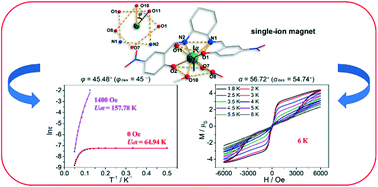Salen-type mononuclear dysprosium complex displays significant single-molecule magnet performance†
Abstract
Three salen-type mononuclear lanthanide complexes with the general formula [Ln(5-NO2salcy)(NO3)(CH3OH)2] (Ln = Dy (1), Ho (2) and Er (3)) have been designed and synthesized by reactions of N,N′-bis(5-nitrosalicylaldehyde)ethane-1,2-cyclohexanediamine (5-NO2salcyH2) with various lanthanide nitrates. Crystallographic analysis reveals that all three complexes 1–3 are of isomorphic mononuclear structures, in which Ln3+ ions are eight-coordinated forming a near square antiprism geometry with D4d symmetry. The alternating-current (ac) magnetic analysis reveals that complex 1 exhibits significant SMM performance with an energy barrier of 64.94 K and a surprising hysteresis temperature of up to 6 K under zero field, as well as an energy barrier of 157.78 K under optimized 1400 Oe. The study on its magnetism–structure relationship supports that the outstanding energy barrier and hysteresis temperature of complex 1 result from the high coordination symmetry and configuration of the oblate (axially elongated) electron cloud densities for the Kramers Dy3+ ion. Notably, it has a remarkable performance compared with single-molecule magnets (SMMs) of numerous salen-type dysprosium complexes. This approach affords a strategy for preparing high performance salen-type dysprosium SMMs to further study their magnetism–structure relationship.



 Please wait while we load your content...
Please wait while we load your content...